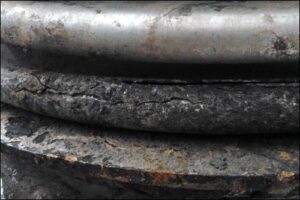1 What kind of corrosion does stainless steel have?
Among the many industrial applications, stainless steel offers corrosion resistance that is satisfactory today. According to the experience of use, in addition to mechanical failure, stainless steel corrosion is mainly manifested in: a serious form of corrosion of stainless steel is local corrosion (i.e. stress corrosion cracking, point corrosion, intergranular corrosion, corrosion fatigue and crevice corrosion). These failures due to localized corrosion account for almost half of the failures. In fact, many failures could have been avoided with reasonable material selection.
(a) Stress Corrosion Cracking (SCC): A general term for the intergenerational failure of stress-bearing alloys in corrosive environments due to the expansion of the strong grain. Stress corrosion cracking has a brittle fracture pattern, but it can also occur in materials with high toughness. The necessary conditions for the occurrence of stress corrosion cracking are the presence of tensile stress (whether residual or imposed, or both) and a specific corrosion medium. The formation and expansion of the pattern is approximately perpendicular to the direction of the tensile stress. This stress value, which causes stress corrosion cracking, is much smaller than the stress value required to fracture the material in the absence of the corrosion medium. At the microscopic level, the crack that passes through the grain is called a transgrain crack, and the crack that expands along the grain boundary is called a crack along the grain, and when the stress corrosion crack expands to one of its depths (here, the stress on the cross section of the loaded material reaches its fracture stress in air), the material breaks off as normal (in ductile materials, usually by polymerization of microscopic defects). Therefore, a section of a part that fails due to stress corrosion cracking will contain characteristic areas of stress corrosion cracking as well as areas of “toughness” associated with the polymerization of the already micro-defects.
(b) Point corrosion: is a form of localized corrosion that causes corrosion. Therefore, it is not surprising that in some corrosive media, the inter-grain boundary may be corroded first. This type of corrosion is called intergranular corrosion, and most metals and alloys may exhibit intergranular corrosion in a specific corrosion medium.
(d) Crevice corrosion: a form of localized corrosion that may occur entirely in a solution-stagnant crevice or in a shielded surface. Such gaps may be formed at metal-to-metal or metal-to-non-metal joints, e.g., at junction candles with rivets, bolts, spacers, valve seats, loose surface deposits, and sea life.
(e) Total corrosion: is the term used to describe the corrosion phenomenon that occurs in a relatively even spooning manner over the entire alloy surface. When full-scale corrosion occurs, the village material becomes progressively thinner as a result of corrosion, and even material corrosion fails. Stainless steel may exhibit full corrosion in strong acids and bases. The problem of failure due to full-scale corrosion is not of much concern, as it can usually be predicted by a simple immersion test or a review of the literature on corrosion.
2 How is the corrosion resistance of common stainless steel?
304 is a versatile stainless steel that is widely used in the manufacture of equipment and machinery that requires good overall performance (corrosion resistance and formability).
301 Stainless steel exhibits significant process hardening during deformation and is used in a variety of applications where higher strength is required.
302 stainless steel is essentially a variant of 304 stainless steel with a higher carbon content, which can be cold rolled to achieve higher strength.
302B is a stainless steel with a high silicon content, which has a high resistance to high temperature oxidation.
303 and 303Se are easy to cut stainless steels containing sulphur and selenium, respectively, and are used in applications where easy cutting and sheeting are the main requirements and where high brightness is required. 303Se is also used in the manufacture of parts that require hot heading, as it has good heat machinability under these conditions.
304L is a variant of 304 stainless steel with a low carbon content and is used where welding is required. The lower carbon content minimizes the precipitation of carbide in the heat-affected zone close to the weld, which can lead to intergranular corrosion (weld erosion) in stainless steel in some environments.
304N is a stainless steel containing nitrogen, which is added to improve the strength of the steel.
305 and 384 stainless steels contain high levels of nickel and have low process hardening rates, making them suitable for a variety of applications where cold forming properties are required.
308 stainless steel is used to make welding rods.
309, 310, 314 and 330 stainless steels have higher nickel and chromium content in order to improve the oxidation resistance and creep strength of the steel at high temperatures. The 30S5 and 310S is a variant of 309 and 310 stainless steel, the difference is only a low carbon content, in order to make the weld near the precipitation of carbide to a minimum. 330 stainless steel has a particularly high carburizing capacity and thermal shock resistance.
316 and 317 Stainless steel contain molybdenum, making them significantly more resistant to point corrosion than 304 stainless steel in marine and chemical industry environments. Of these, type 316 stainless steel comprises variants including low carbon stainless steel 316L, high strength stainless steel 316N containing nitrogen, and free cutting stainless steel 316F with a high sulphur content.
321, 347 and 348 are stainless steels stabilized with titanium, niobium and tantalum, respectively, and are suitable for welding at high temperatures. 348 is a stainless steel suitable for the nuclear power industry and has a certain limit on the amount of tantalum and drill.


